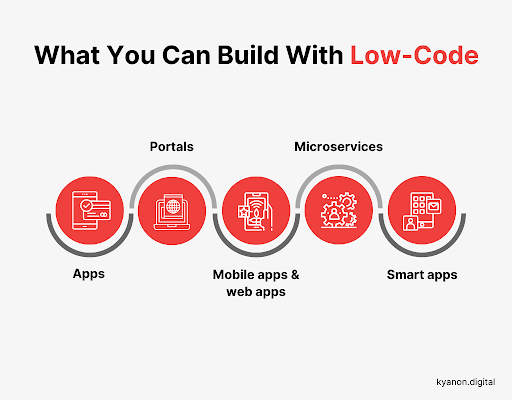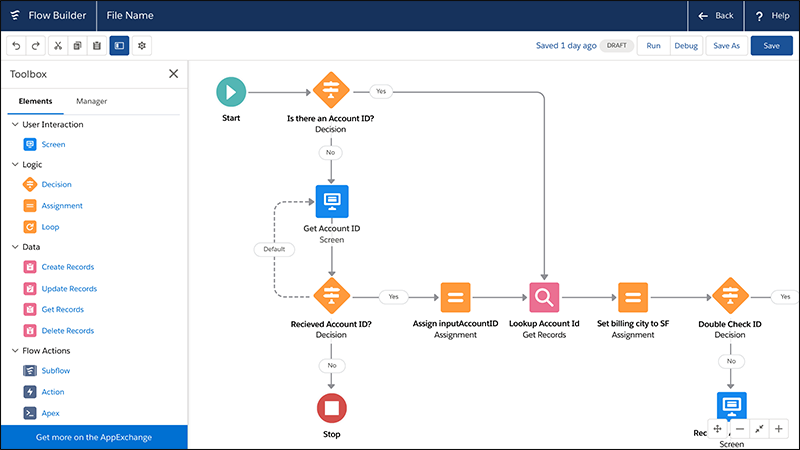Free Ideas On Picking Legacy application modernization with Low-code
Wiki Article
In Terms Of The Integration Capabilities, Low-Code Development Of Applications Has Numerous Advantages.
Low-code application development offers significant advantages when it comes to integration capabilities, which are vital for developing applications that seamlessly connect with diverse systems and services. Here are some of the main benefits of APIs and connectors that are pre-built.
An extensive range of connectors. Low-code systems typically include a wide range of built-in connections to enterprise systems that are popular (e.g. cloud-based services, databases, CRM). It makes it easier to integrate these systems.
API Integration: A lot of low-code platforms offer API integration capabilities, allowing developers to connect to other service and data sources with ease.
Easy To Use
Drag-and-Drop Integration: A variety of integration tasks are completed by using drag-and-drop interfaces. This allows developers and nondevelopers to create complicated integrations using little or no programming.
Visual Workflow Builders: Tools for creating workflows and data flow that are visually represented help to learn and configure integrations in a much more simple manner.
Standardized Integration Methods:
SOAP and restful services: Supporting web services standard protocols such as REST and SOAP makes integration easy with a large variety of platforms and systems.
OData, Other Standards Support for standards like OData helps to access and manipulation data across applications and platforms.
Real-Time Data Synchronization:
Real-Time Integrations: Lowcode platforms can manage data synchronization in real time between the system and applications making sure that data is updated and uniform throughout an company.
Event-Driven Architectures: A few platforms provide event-driven architectures that enable applications to react in real-time whenever certain events happen, which is vital for dynamic applications.
Legacy System Integration:
Connecting old and new Systems Low-code platforms typically provide tools to integrate with older systems, which allows organizations to upgrade their IT infrastructure without radically overhauling the existing system.
Data Migration Tools: The built-in instruments for data migration facilitate the transfer from old systems to applications developed on low-code platforms.
Integration of Third-Party Services:
Integration with Cloud Services: Seamless integration with cloud-based services like AWS, Azure, and Google Cloud allows for the simple deployment and scaling of applications.
Business Integration of Applications: Low code platforms can be integrated with different business software like Salesforce, SAP and Microsoft Dynamics. This creates a seamless workflow between the business functions.
Simplified management of data:
Unified Data Models: A few lowcode platforms provide common coding models, which make it easier to manage managing data as well as integration and synchronization between various systems.
Data Connectors are data connectors that have been pre-configured that offer quick access to data sources and permit manipulation.
Security and Compliance
Low-code platforms help ensure integrations comply with security protocols and standards to protect data during transit as well as in its rest.
The platforms include features that ensure the integration is compliant with regulations (e.g. GDPR, HIPAA), giving companies that handle sensitive information security.
Extensibility:
Low-code platforms often meet complicated integration requirements by incorporating custom code or scripts. They offer flexibility without compromising the accessibility.
Plug-in Ecosystems. An ecosystem of extensions and plug-ins will allow you to enhance your integration capabilities, and add new features whenever you need to.
In the end, the integration capabilities of low-code applications development platforms make them an effective device for building efficient, interconnected and scalable apps. These platforms streamline the process of integrating disparate IT systems, improve the flow of information, and assist companies adopt technologies that are already in use, and also make use of new ones. Follow the top rated Low-code Platform for application development tips for more recommendations including ms azure sql, mobile app development platforms, cross platform mobile app development, app platforms, software for app development, rapid applications, develop web application, push notifications android, build a docker container, ms azure sql and more.

Low-Code Software Is Cost-Effective.
Low-code app development offers numerous benefits, including cost efficiency. This is an appealing choice for companies who wish to optimize development budgets without compromising on quality. Here are a few of the most important benefits:
Reduced Coding: Low-code platforms reduce the amount of manual coding needed which reduces the time and energy spent by developers when creating applications. The result is lower labour costs.
Fewer Developers: Because low code development is speedier and simpler and less complex, there are fewer developer resources required. This will drastically lower the cost of hiring and staffing.
Faster time to market
Accelerated Development: Low-code platforms provide visual development tools, pre-built components, and other capabilities that facilitate rapid development of applications. Businesses can introduce their products to the market much faster. This could lead to more rapid growth in revenue and enhance your position in the marketplace.
Rapid prototyping: By developing and testing prototypes in a short time companies can decrease the time they spend in the development phase and enable faster iterations based on user feedback.
Lower Maintenance Costs
The modular structure and standard components of applications developed with low-code platforms makes them simpler to maintain. This means that they are less likely to require ongoing maintenance and support costs.
Automated updates: Many low-code platforms automatically manage updates and patches, ensuring that the applications are safe and up to date without the need for extensive manual intervention.
Efficient Resource Utilization:
Contributions by Non-Developers Low-code platforms permit non-developers as well as business users to be involved in the development process. This allows businesses to leverage the skills of a broader range of employees, reducing dependency on developers who are highly paid.
Utilizing IT resources efficiently: IT departments will be able to focus on strategic projects, instead of being bogged down in mundane development tasks. This will boost overall efficiency and productivity.
Scalable Pricing Models:
Subscription-Based Pricing: A lot of low-code platforms offer flexible, subscription-based pricing models that scale in line with the amount of usage. This enables businesses to align their expenditure with their needs and grow.
Pay-as-you go options Certain platforms offer pay-as-you-go options, ensuring that businesses only pay for the resources they utilize and can be especially advantageous for small and start-up companies with limited funds.
Reduce the cost of third-party software:
Built-in Functionalities: Low-code systems typically come with built-in functions and integrations that reduce the need for additional third-party tools and software, resulting in cost savings on licensing fees and subscription fees.
Pre-Built Integrations: The possibility of having of pre-built integrations to popular systems and services minimizes the need for custom development. Savings on both time and money.
Higher ROI
More efficient return on investment Rapid development, less expensive and faster time to market, means that businesses will see a higher ROI (ROI) for their software.
Increased agility: Businesses are able to respond quickly to changes in the market or in customer demand and this allows businesses to stay relevant and benefit from new opportunities.
Lower Training Costs
Low-Code Platforms have User-Friendly Interfaces. The intuitive and user-friendly interfaces help ease the learning curve for new users. This reduces the need for intense training programs.
Accessible Resources: A lot of platforms that use low-code offer comprehensive educational materials, tutorials as well as community support. This reduces the requirement for formal education as well as the costs associated with it.
Streamlined Collaboration:
Enhance Collaboration Tool: The built-in collaboration tool facilitates better collaboration and communication between team members. This results in faster development processes and also reduces the cost of projects.
Unified Development Environment: A single unifying development environment can help simplify workflows and decreases the complexities and costs associated with managing multiple tools and platforms.
In general, applications that use low-code cost less due to their ability to cut costs of development and maintenance and to speed up time-to-market to maximize resource use and to allow for flexibility in pricing. Low-code provides significant financial benefits for companies. Take a look at the recommended Legacy application modernization with Low-code for more recommendations including cross platform mobile dev, application modernization, mobile development platforms, app modernisation, cross platform app development, application modernization software, app modernisation, develop web application, cross platform app development, app platforms and more.

The Benefits Of Low-Code Development For Community Members And Vendors
Low-code application development platforms provide substantial advantages in terms of the support provided by vendors and communities. Both is essential to ensure successful implementation, ongoing maintenance and constant improvement of applications. Here are a few of the major benefits: Support from vendors
Comprehensive Technical Support:
Support Teams: Most platforms using low-code have special support teams that assist with technical problems, troubleshooting and guidance.
24/7 Support Some suppliers are available all hours of the day, which is beneficial to businesses operating in multiple time zones.
Training and Onboarding
Structured Training Programs: Vendors often offer structured training courses, including tutorials, webinars and certification courses to help users get up to speed quickly.
Many companies offer customized onboarding that helps customers to utilize the platform effectively and adapt it to their needs.
Regular Updates, Enhancements and Improvements:
Continuous Improvement: Low code platform vendors provide regular updates that include new security patches, features and improvements to performance. This ensures that the platform remains current and secure.
Feedback integration: Vendors often integrate user feedback during their development process to ensure that their platform is able to meet the changing requirements of users.
Comprehensive Documentation:
Documentation - Detailed: A comprehensive and well organized documentation, ranging from basic use to advanced customizations and is usually available. This allows users to solve problems independently.
API References: The detailed API documentation assists developers in integrating the low-code platform with other systems and customize their applications to be effective.
Professional Consulting Services
Expert Consulting : Vendors offer consultation services such as designing architecture and complex implementations. They do this to ensure that users are able take full advantage of the platform.
Custom Development Services Some vendors offer customized development services for specific functions or integrations that aren't available in the standard package.
Community Support
Active User Communities:
Forums and Discussion Panels: Many low-code platforms have vibrant online communities where users are able to ask questions, debate solutions, and collaborate on best practices.
Local and virtual User Groups and Meetups, provide opportunities for users to discuss their experiences, learn from other users, and connect with.
Knowledge Sharing & Collaboration:
Community-Contributed Resources: Users often share templates, modules, and extensions that they have developed, which can be reused or adapted by others, accelerating development and innovation.
Crowdsourced Problem-Solving: The collective experience and experience of a group can be an invaluable source to solve problems and discover creative solutions to difficult problems.
Learning and Development:
Community-led training Community-led training: Many groups provide workshops, webinars, and workshops led by experts who have experience in the area.
Online Tutorials and Courses Community members regularly create and share online courses, tutorials, and how-to guides, enhancing the learning resources that are available to all users.
Feedback and Influence
Product Feedback Channels: Community forums typically include channels for providing feedback to the vendor which may influence the creation of new features or improvements.
Beta Testing Programs: Community members who are active could get the chance to take part in beta-testing programs. It gives them the first glimpse of new features and also a a chance to help shape the platform’s evolution.
Recognition and Encouragement
Many vendors have community recognition programs, for example MVP programs (Most Valuable Professional) to acknowledge the efforts of their members who are involved in their communities.
Peer Support: Community members frequently provide support to peers by sharing their knowledge and offering guidance to users who are not as familiar, fostering a collaborative and positive environment.
Overall the combination of strong vendor support and an active and engaged community creates an entire support network for the development of low-code applications. Users will benefit from the experience and resources needed to create and deploy their application.
